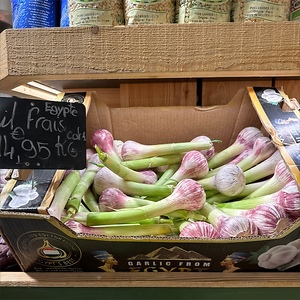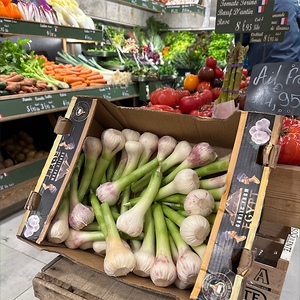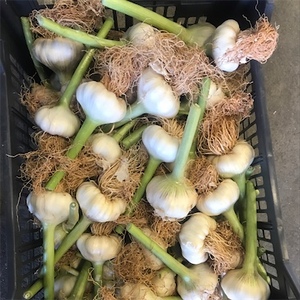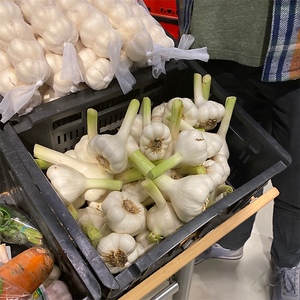


Egyptian Garlic
Estimated Inventory, lb : 0
Description/Taste
Egyptian garlic is smaller in size than common white garlic and has a globular, tear-drop bulb that connects into a stem, also known as a neck, that may appear green when fresh and brown when dried. The outside of the bulb is covered in thin, white papery coatings that are flaky, dry, and brittle. When peeled away, there is another layer known as the clove skin that ranges in color from white to tan and is tightly adhered to the clove. Egyptian garlic contains many cloves and can develop up to twenty-five cloves in one bulb. The cloves are clustered together, forming multiple layers of slender and slightly flattened shapes, and the outer cloves are typically larger in size than the inner cloves. When raw, Egyptian garlic has a crisp texture with a sharp, pungent, and spicy flavor, and if crushed, it will emit a strong aroma. This flavor and aroma will lessen with cooking and will develop a mild, savory flavor.
Seasons/Availability
Egyptian garlic is available year-round, with a peak season in the late spring through fall in Egypt.
Current Facts
Egyptian garlic, botanically classified as Allium sativum, are small bulbs with numerous cloves found on a plant that can grow up to sixty centimeters in height and belongs to the Amaryllidaceae family. Also known as a silverskin variety, Egyptian garlic is one of the longest-storing varieties of garlic and is favored for its pungent flavor. In Egypt, garlic has recently increased in production, and with the variety’s long shelf-life, it has begun to be exported to countries worldwide, providing an essential source of income for Egyptian farmers.
Nutritional Value
Egyptian garlic is an excellent source of vitamins C and B6, selenium, and manganese, and also contains some fiber, phosphorus, potassium, calcium, iron, and copper.
Applications
Egyptian garlic can be consumed raw, thinly sliced and added to salads, or it can be chopped and mixed into sauces, dips, and spreads. The small bulbs are most popularly utilized in cooked applications and can be lightly sautéed in olive oil as a base for vegetables, soups, stews, meats, and rice. Whole bulbs can also be roasted for a caramelized flavor. In Egypt, garlic is incorporated into many traditional dishes such as ful, which is a popular street food consisting of fava beans in garlic, olive oil, onion, and lemon juice. This mixture is used at breakfast and is spread on eggs or pita bread. Egyptian garlic is also used in fatta, which is a dish made for religious occasions that cooks garlic in tomato sauce with meat, broth, and fried bread, or in Molohkeya, a green vegetable soup cooked with meat and garlic served over bread or rice. Egyptian garlic pairs well with meats such as lamb, poultry, beef, and rabbit, fish, chickpeas, rice, tomatoes, onions, and peppers. The bulbs will keep up to one year when stored in a cool, dry, and dark place.
Ethnic/Cultural Info
Garlic has been used in Egypt since ancient times and was highly revered for its life-giving properties and intense flavor. Discovered in the ancient tomb of King Tutankhamen who was Pharaoh between 1332-1323 BCE, Egyptians believed garlic would protect the pharaoh’s body from evil spirits due to its strong odor. Egyptians believed so strongly in this protection that they would also chew cloves of garlic before taking a journey during the night to shield them from misfortune and evil. In addition to protection, ancient Egyptians believed that garlic would provide strength, and the cloves were fed to the builders of the pyramids to increase their endurance.
Geography/History
Garlic is native to Central Asia and was spread to Egypt via trade routes and traveling merchants. While the exact origins of Egyptian garlic are unknown, garlic has been used since ancient times in Egypt and was believed to have been introduced around 3200 BCE. Today Egyptian garlic is primarily cultivated in upper Egypt and sold at local markets. It is also exported to countries across the world, including Sweden, Brazil, Taiwan, Canada, the United States, Malaysia, Vietnam, Saudi Arabia, Russia, Bangladesh, and Pakistan.
Recipe Ideas
Recipes that include Egyptian Garlic. One












